来吧兄弟,一起玩一起讨论!
您需要 登录 才可以下载或查看,没有账号?注册

×
| The TeraStation Reborn: Buffalo TeraStation III Reviewed |  |  |
| Tim Higgins | | April 08, 2009 | Introduction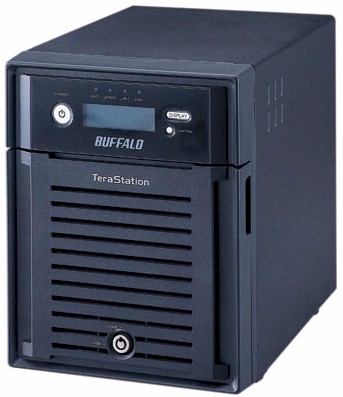
| At a Glance | | Product | Buffalo TeraStation III (TS-X2.0TL/R5) | | Summary | Updated, faster version of Buffalo's top-of-the-line quad-drive small-business NAS | | Pros | • 50 MB/s RAID 5 reads
• NFS and DFS support
• Dual Gigabit Ethernet with failover, aggregation | | Cons | • Slow USB backup
• No logging; miserly status
• No eSATA port |
Buffalo's LinkStation Pro XHL restored my faith in Buffalo's ability to build a high-performance, reasonably-priced single drive NAS. With the TeraStation III, it looks like Buffalo can apply the same price / performance improvement magic to a four-bay RAID 5/10 product.
The III bears a family resemblance to its TeraStation Live and Pro II predecessors. But it's about four inches shorter, although it has the same footprint. Buffalo sent the 2 TB version for review. But you can also get a Tera III in a 4 TB configuration and a 6 TB version will follow soon.
Figure 1 shows the lockable front door swung open to reveal the four hot-swappable 3.5" SATA drives snug in their trays.
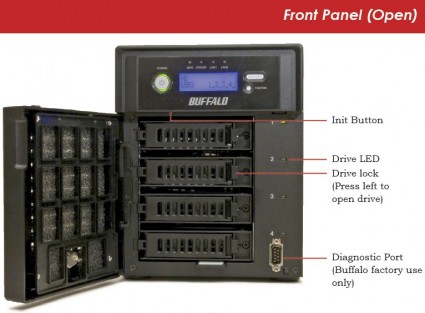
Figure 1: Tera III with door openI'm sure it's probably a security "feature", but I didn't like that you could not leave the door unlocked and remove the key. You also can't see the drive LEDs without opening the door, which is disappointing if you like to watch drive activity lights flashing away. Don't get too excited about the Diagnostic Port behind the front door. The serial port appears to provide a Linux console output. But it didn't respond to the keyboard input from the terminal emulator that I used to check it out.
The Power Mode switch caused a bit of confusion because it came set to Auto and I don't use Buffalo's NAS Navigator utility. It took a few unrequested shutdowns for me to remember to flip it to Manual, which kept it up and running until I shut it down by press-and-holding the front panel Power button.
Even if you don't use the NAS Navigator, you can set three sleep / wake schedules for power management. The Function button up next to the LCD display initiates a RAID rebuild after hot-swapping a drive, dismounts USB drives and starts a copy from a USB drive. The Display button cycles you through the various status displays that include Link Status for both Gigabit Ethernet ports, Drive status, IP address, RAID status, Date / Time and Firmware revision. I found it handy that the display will stay on the selected screen until you change it.
The Tera III draws 45 W when active and 12 W when sleeping. You'll hear the easily-replaceable fan when the NAS is booting, but it quiets down when boot time is over. Like the Pro XHL, the Tera III's fan stayed quiet, even when I ran the heavy-use iozone tests. The bulk of the III's noise is from the four drives, which ran very quietly and make the Tera III one of the quietest four-drive NASes that I have seen.
Internal DetailsThe slideshow has some good pictures of the III's insides, which are easily accessed by removing five screws and sliding the metal cover off. Given the III's target business audience, Buffalo has tried to make the power supply and fan—the highest failure rate parts after the drives—easily replaceable. The fan is mounted on a removable panel and has a standard mini power connector and the power supply sits right on top.
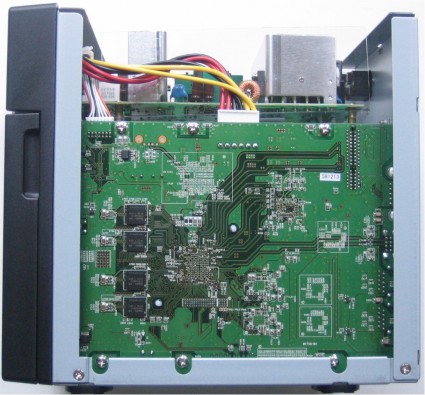
Figure 2: Inside right viewGetting the main board out so that I could take its picture required a bit more effort, including removing the rear panel. I also had to remove the heatsink (secured via an adhesive thermal pad) to find that the Tera III is the first NAS I have seen to use another new Marvell processor, an MV78100-A0 C080 Single-core ARMv5TE-compliant Feroceon clocked at 800 MHz.
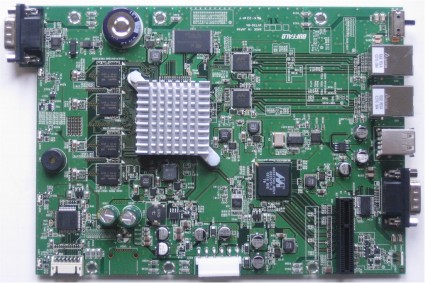

Figure 3: TeraStation III main boardThe processor is teamed with a Marvell 88SX7042 SATA II controller that handles the four 3.5" WD WD5000AAKS Caviar Blue 500 GB drives that came in the 2 TB version sent for review. Like other Buffalo NASes, the drives are XFS-formatted.
The memory complement includes 512 MB of soldered-on-board RAM as well as 512 MB of flash. Dual Marvell 88E1118s provide two Gigabit Ethernet ports that support independent, redundant, auto-failover and multiple aggregation modes and 4, 7 and 9 K jumbo frames. I also found an NEC UPD78F0513 8-bit single-chip microcontroller, which looks like it supports the front LCD panel and buttons.
Two USB 2.0 ports can be used to connect USB flash and hard drives for expansion or backup and USB printers for sharing. UPS synchronization is supported via a single serial port, which I thought is a step backward considering the USB interfaces used by many of today's UPSes. I was also disappointed to find no eSATA port that could handle faster (than USB) attached drives for speedier backup.
|
|
![Emby最新电视客户端Emby for TV v2.0.98g [Unlocked] 全功能解锁版](data/attachment/block/43/430ae5785ca9c77cc80035d000f160c2.jpg) Emby最新电视客户端Emby for TV v2.0.98g [11728 人气#黑白群晖
Emby最新电视客户端Emby for TV v2.0.98g [11728 人气#黑白群晖 备份好cookie防止PT站关闭游客模式无法登录2059 人气#PTer物语
备份好cookie防止PT站关闭游客模式无法登录2059 人气#PTer物语 群晖为NVME的SSD创建存储空间3431 人气#玩机宝典
群晖为NVME的SSD创建存储空间3431 人气#玩机宝典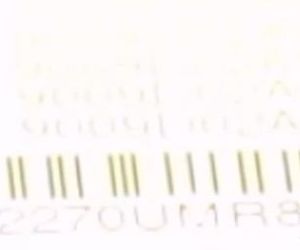 分享一个SA6400 的SN1466 人气#黑白群晖
分享一个SA6400 的SN1466 人气#黑白群晖